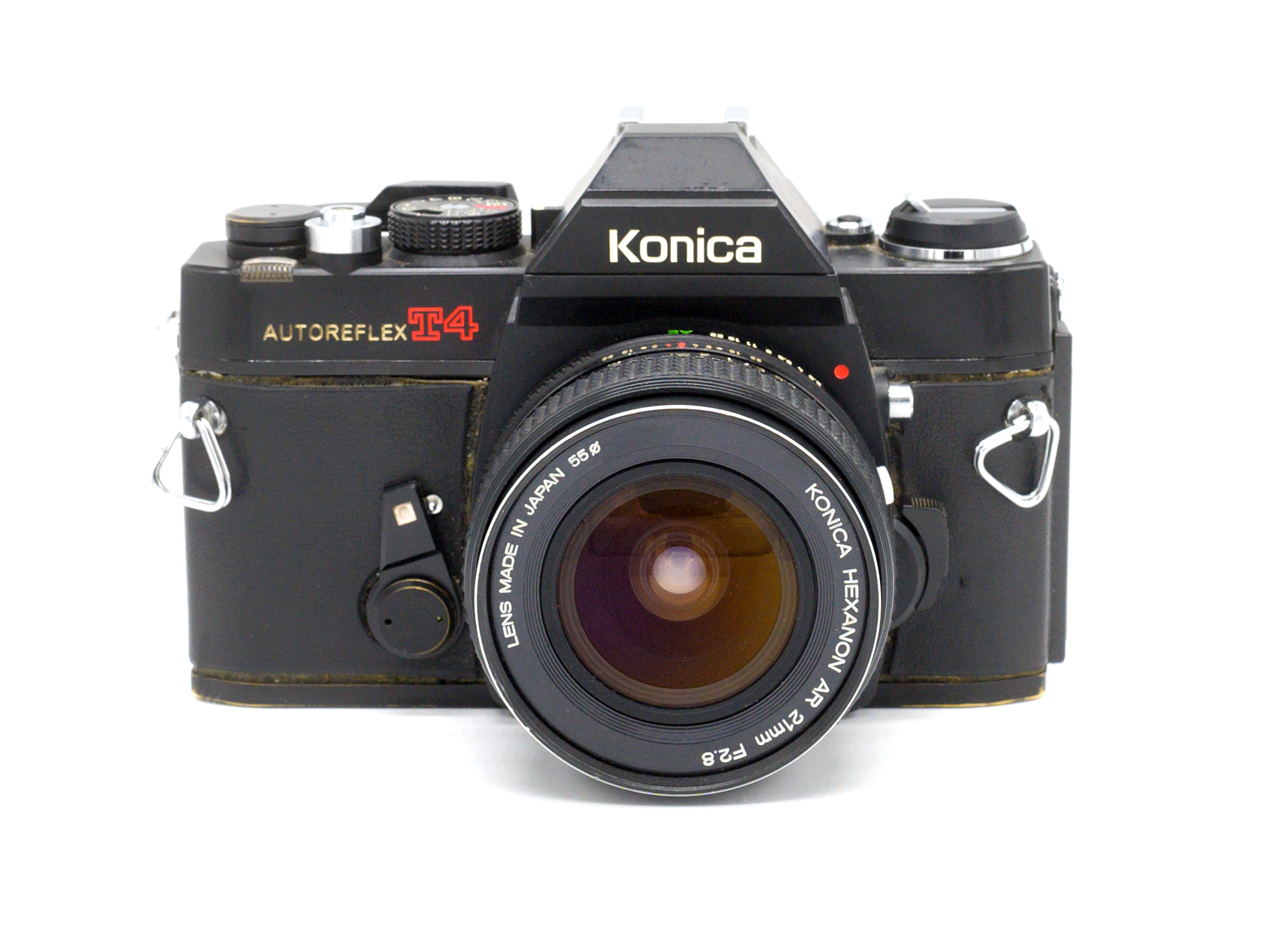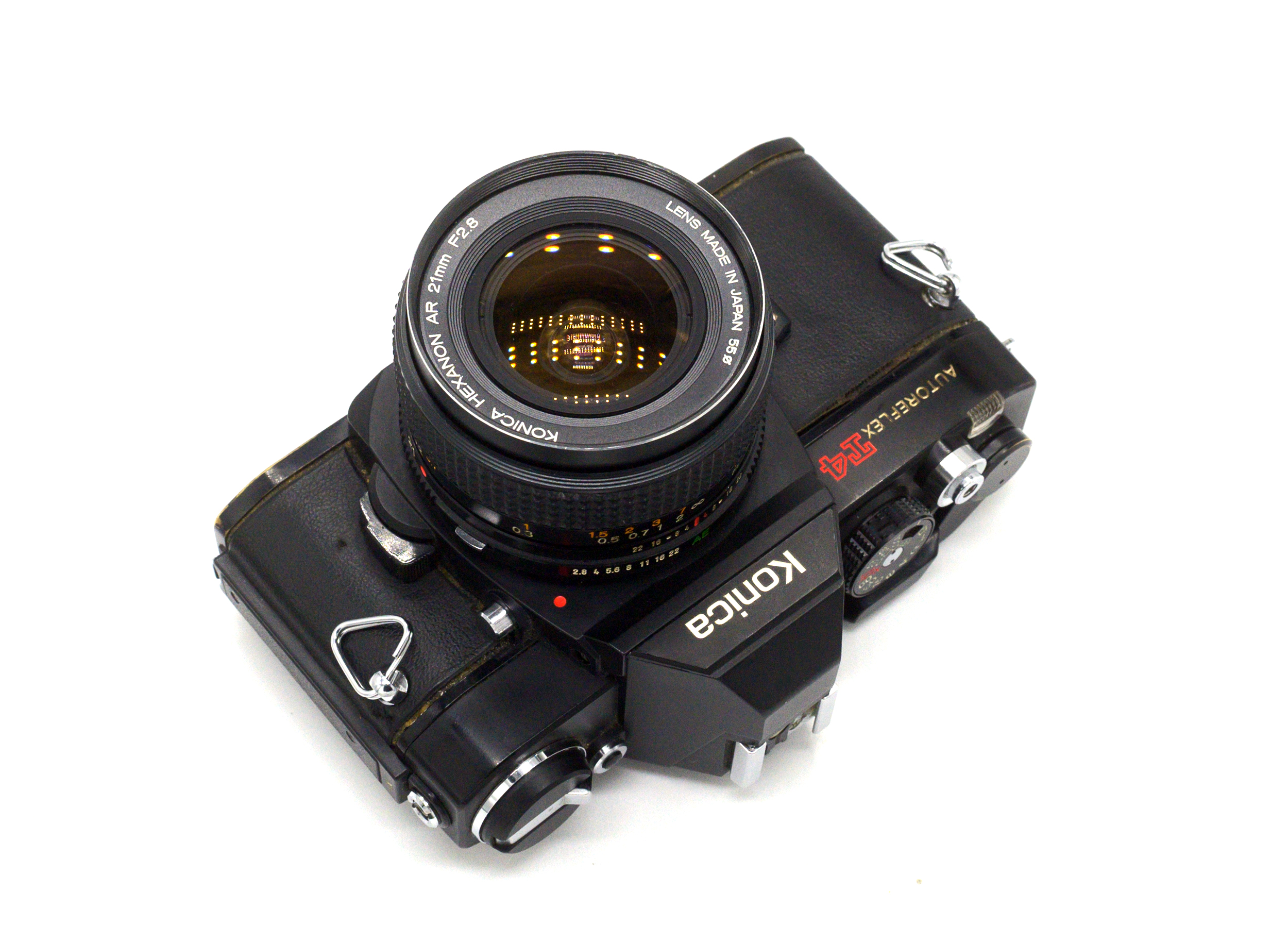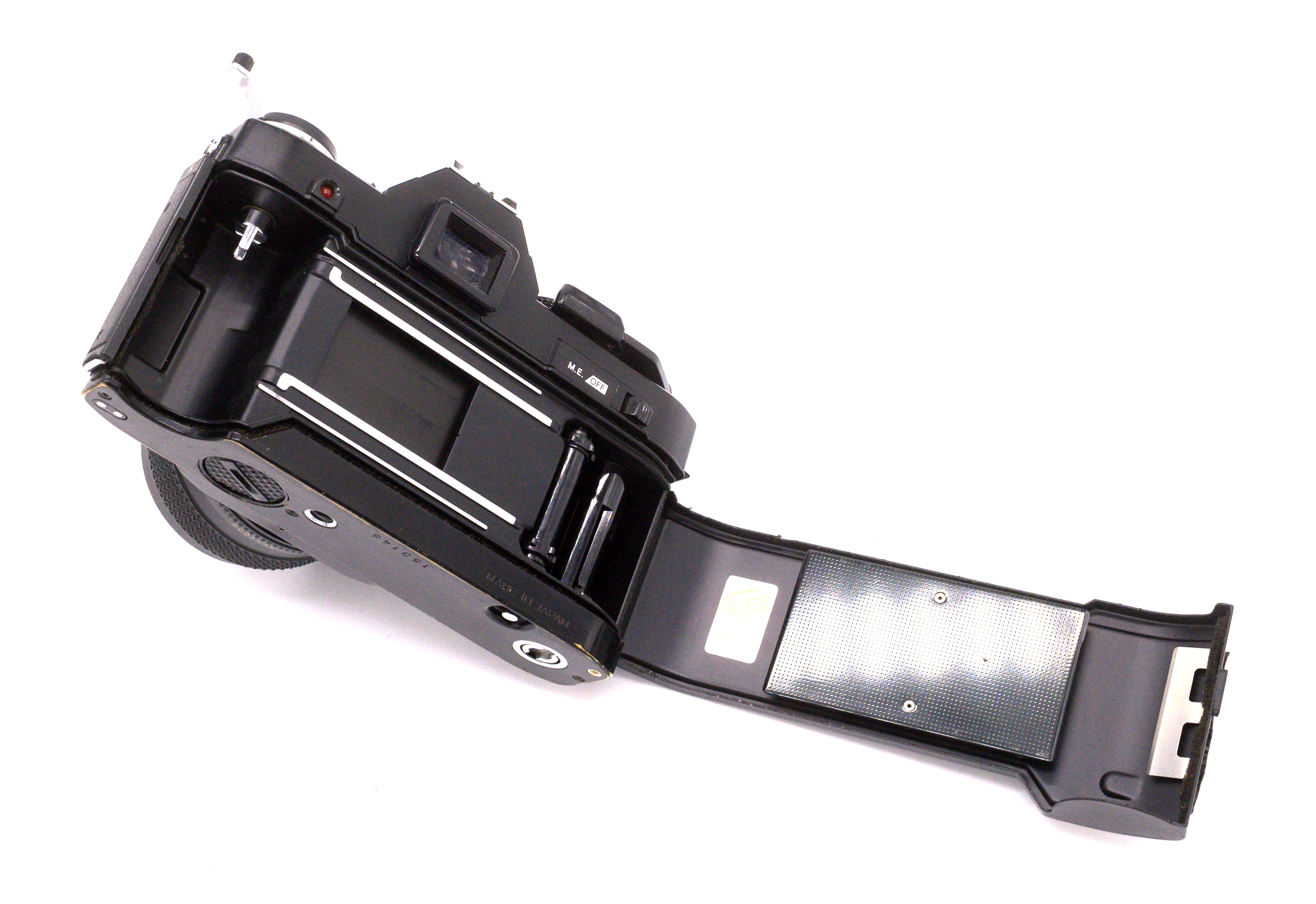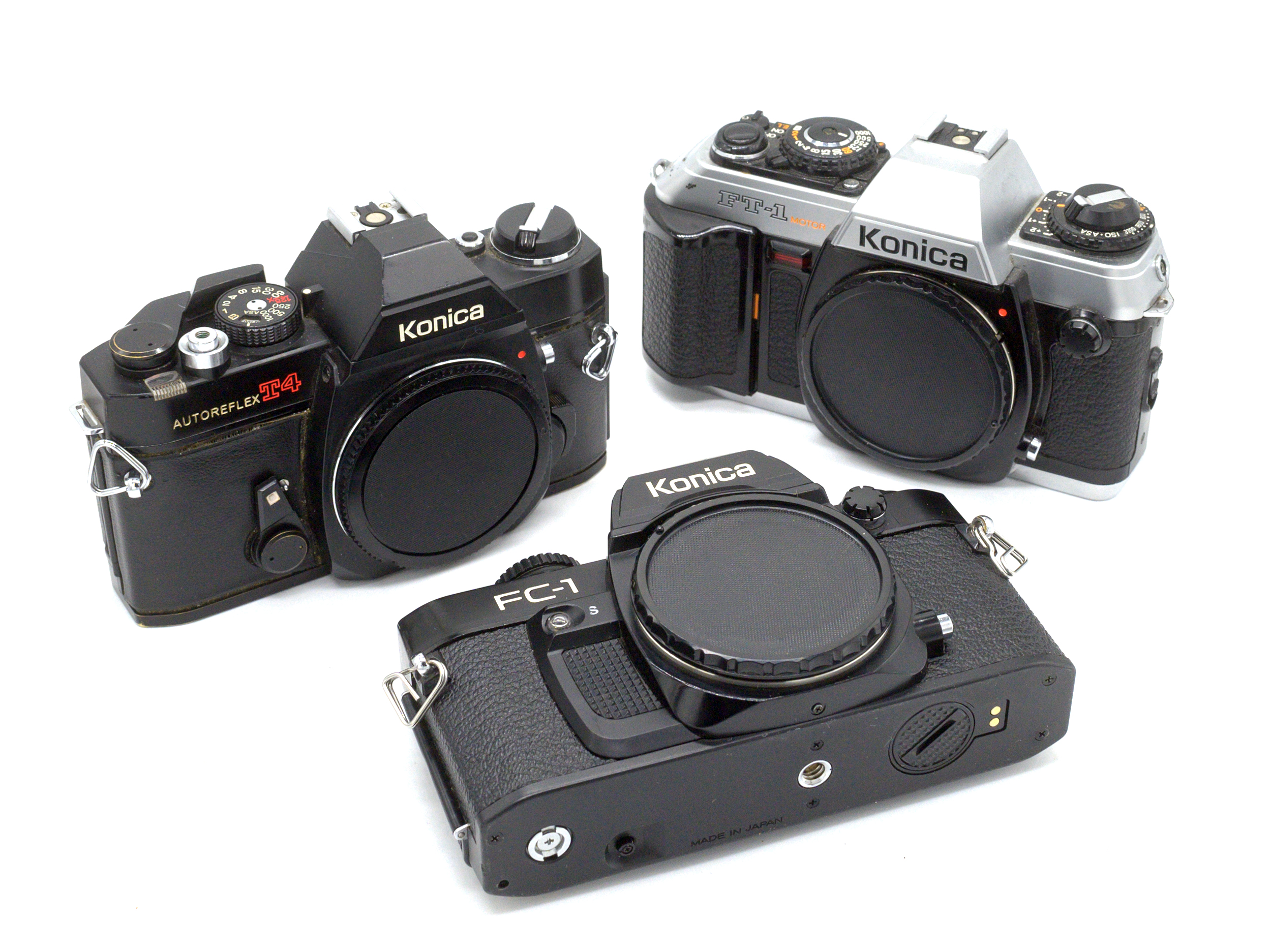
Konica’s short-lived 1978-79 Autoreflex T4 was the last of its mechanical-shutter “Autoreflex” line of 35mm SLR cameras, which has started with 1968 “Autoreflex T” (or “FTA” in Japan). The Autoreflex platform was designed for a “shutter speed priority” autoexposure operation: where the user would select a shutter speed and the camera would select the appropriate aperture given the light meter reading. In this system, each AR lens has a moveable arm whose swing opens and closes the lens’ aperture. When the lens is set to “AE” (or “EE” on older lenses), the body holds the arm to keep the lens at its wide open aperture for focusing purposes. When the internal light meter gauges the appropriate aperture given the selected shutter speed, when the shutter is tripped, the body’s arm moves to stop down to the appropriate aperture. Although the T was certainly no professional tool, it was all-metal, durable, and completely mechanical. It would not be until 1972 that Nikon would introduce its first automatic “aperture priority” camera, the Nikkormat EL, and not until the 1980 F3 that it would incorporate aperture-priority autoexposure into one of its professional cameras.
The trend during the mid-1970s was the production of smaller-bodied SLRs. The 1972 Olympus OM-1 is probably the most famous of these. Following suit in 1976, in a major departure from its bulky T/T2/T3 series, Konica introduced the consumer-oriented “TC” (or “ACOM-1” in Japan). Although the specifications of the TC were not particularly impressive, it did sport one of the newest, most durable, reliable, if not the loudest, of the Copal mechanical shutters: the Square CCS-M. The TC sold very well for the time and was produced all the way into 1982. With Konica’s flagship T3 becoming a little long in the tooth, Konica introduced the T4, incorporating the essential features of a T-series camera into the general frame of a TC. Over the TC, the T4 had a variety of additional features, such as slow speeds down to 1 second, a depth-of-field preview lever, double exposure capability, the ability to use an external motor drive, a battery check light, a brass rather than plastic baseplate, and a slightly brighter focusing screen. Because the T4 was arguably uncompetitive in 1978 with the new generation of electronic-shutter SLRs, Konica quickly replaced it with the motor-driven, electronic-shutter FS-1 in 1979, and then the more basic electronic-shutter FC-1 in 1980. The T4 was Konica’s last mechanical-shutter camera until the 1985 TC-X.
During the late 1970s, Konica began outsourcing the production of some of its final generation of SLR lenses to Tokina. These later lenses are generally identifiable by a minimum aperture of f/22 rather than f/16. Konica’s standard kit lens for the T4 was a “new” version of its 50mm f/1.7, with the Tokina-sourced 40mm f/1.8 beginning to replace it in 1979. While the 50mm f/1.7 Hexanon is perhaps one of the great standard bundled lenses of the 1970s, the 40mm f/1.8 is fairly average.

Specifications
| Lens Mount | Konica AR |
| Minimum Aperture | f/16 |
| Shutter | Copal Square CCS-M |
| Shutter Speeds | B, 1 – 1/1000 |
| Flash Sync | 1/125 |
| Viewfinder Coverage | 90% / 0.89x |
| ASA Range | 25 – 1600 |
| Batteries | 2 x PX625 |
| Weight | 530g |

Operation
Viewfinder: Although the T4 viewfinder is a little brighter than TC, it is still somewhat dim even with lenses faster than f/2. The 90% viewfinder coverage and 0.89x magnification are average for the class of camera. The non-interchangeable focusing screen is a standard split-image type. On the right hand side of the viewfinder displays apertures from f/1.7 to f/16 with a black needle indicating the correct aperture given the selected shutter speed. What is rather disappointing is that although the camera will correctly meter and expose at all apertures in a particular lens’ range, the display itself does not include f/1.4 or f/22. The manual addresses this and states for f/1.4 lenses to use part of the “red underexposure area” for lenses with apertures wider than f/1.4. The FS-1 and FC-1 would introduce a new LED viewfinder that displayed apertures from f/1.4 to f/22, and that viewfinder would continue to be used through the FT-1 (but not the TC-X).

Shutter: The Copal CCS-M shutter was brand new in the mid-1970s and was one of the most robust, accurate, and loudest mechanical shutters of the era. The T4’s top shutter speed of 1/1000 was typical of most consumer cameras at the time.
Exposure Lock: The T4 continued in the Autoreflex tradition of being able to lock the exposure through a half-depress of the shutter release. Many other cameras of the era either did not have an exposure lock, used an external button for exposure lock, or had an external “backlighting” compensation button. Exposure lock was noticeably absent from the next three Konica bodies: the FC-1, the FP-1, and the FS-1. The feature would not return until the 1983 FT-1.
Motor Drive: The T4 was the first of three Konica bodies that could use an external autowinder, the others being the FC-1 and the FP-1. The T4’s proprietary winder can only advance the film (at a slow 1.8 fps) and also adds to the significant noise that the shutter generates.
Depth of Field Preview: The T4 retains the traditional capability to evaluate the depth of field via a switch on the right side of the lens.
On/Off Switch: The T4’s “on/off” switch is activated by slightly pulling the film advance lever backwards, which turns on the meter. To turn “off” the camera, press the large and prominent button on the back of the camera, which will push the advance lever forward. Nice and simple.
Manual Operation: Because the batteries only power the meter/autoexposure system, the camera will operate at all shutter speeds mechanically.
Battery Check: The T4 has a very prominent battery check button with a large red light on the back of the camera that will turn bright red if the batteries are still good. The light is a little overkill for its purpose, but it is better than not having it, I guess.
Flash-Sync: The T4 has a respectable X-sync flash speed of 1/125. The later electronic-shutter FC-1 and FT-1 have a maximum flash sync of only 1/60 with non-proprietary flashes.
Bad Leatherette: With the TC and T4, Konica used some sub-par leatherette that shrank throughout the decades. It looks really bad. Best bet is to scrape it all off and buy one the aftermarket covering for them.
Mercury Batteries: By 1978, most major manufacturers had already discontinued the use of mercury batteries for cameras. The T4, like the TC before it, requires two PX625 1.35V mercury batteries for accurate metering. Although there are multiple ways to substitute the PX625s (Wein cells, MR-9 adapter for silver oxide batteries, wiring in a diode, etc.), none of them are particularly pleasant.
Smallish: While the T4 is noticeably smaller and lighter than the T/T2/T3, the FC-1 and FT-1 are also around the same physical size.

Conclusions
As the swansong of the Autoreflex line, the short-lived T4 incorporates all of the most important features of the “T” line into the smaller frame of the TC. If you prefer smaller and lighter SLRs, or dig the TC but want more functionality, the T4 may suit your needs. Apart from the typical failings of any 1970s SLR, like the light meter, the T4’s robust mechanical shutter can last a long time. Otherwise, there is nothing particularly interesting or innovative about the T4 for the time period it was produced. For me and for those who do not mind electronic shutters, the 1983 Konica FT-1 remains the best Autoreflex-mount camera.
Picked up a T4 with a Soligor 35/2.0 pretty cheap and running it on 675 hearing aid batteries. Found a Exakta lens to Konica AR adapter for a tenner and will use it as a test bed for Exakta mount lenses on film.
But I would pick any Nikon FE/FM camera over the T4 any day.
The only fun Konica SLR camera is the first Autoreflex with changeable film format.
I’m not certain what it is about these, though I understand why many would be a bit nonplussed I suppose, I just find them wonderful. Just something in the handling that I enjoy more than most any other 35mm SLR. There’s a scrappy nature to them and the leatherette feels great. I didn’t particularly like the shutter sound that resonates slightly flat with the poly top-cap, but have grown to love it. The dual-fuction shutter-lock/double-exp button is wonderful in simple design. It’s just an SLR but for me it’s easily one of my favorites… for some reason. 🙂
My real gripes with these include the unusually dark viewfinders and the lack of any real shutter or mirror dampening.
Fair enough. I’ve never found they needed much more dampening personally, at least not from a practical (never any noticeable image shake) standpoint. I wonder if you could flock the box with something. On my main one I replaced the stops/foam in the box with closed-cell, but that’s really all I’ve done except basics… cleaned the prism and finder and etc. That’s *my* only gripe is how susceptible the finder is to dust and how tedious it is to reach and clean, particularly the precariously fiddly nature of the needle/scale sandwich there-in (the first go to me the better part of 2 hours to re-orient everything correctly!). I bet that contributes to how dark the finders are on many copies these days… That and they aren’t particularly bright (compared with a Pentax MX or the likes of similar) finders. Has always been sufficient enough for me, though I can understand that complaint. But yeah…. for one reason or another though, I just keep picking up the T4 to shoot with more than any other, going on 5 years now.